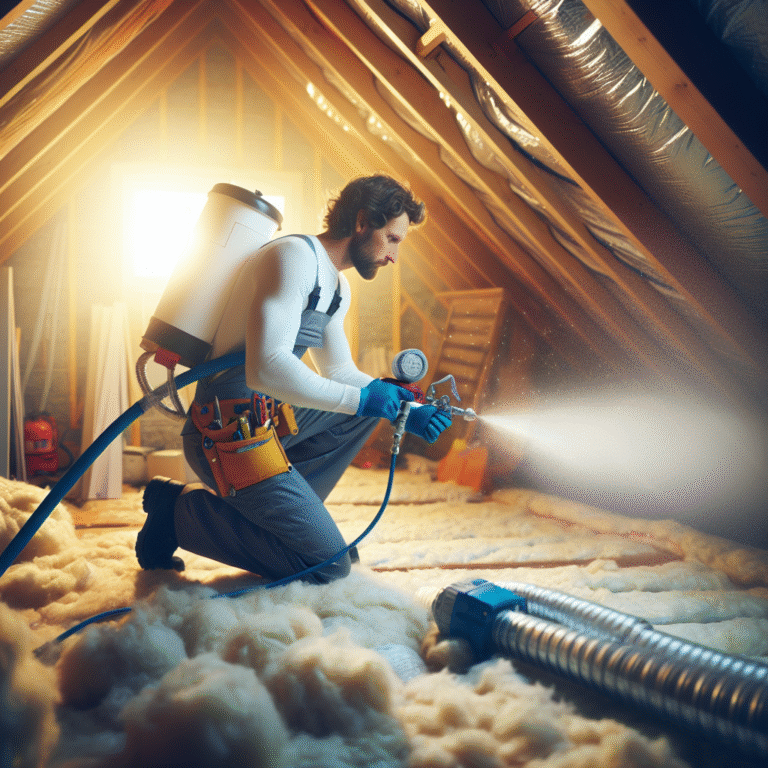-
Table of Contents
“Uncover the truth behind Batt Insulation – separating fact from fiction.”
“Stop falling for common myths about batt insulation and learn the truth! Visit texasinsulationsolution.com to debunk these misconceptions and discover the benefits of proper insulation for your home. Don’t let false information hold you back from a more comfortable and energy-efficient living space. Take action and educate yourself today!”
Introduction
Batt insulation is a popular type of insulation used in homes and buildings to improve energy efficiency and reduce heating and cooling costs. However, there are many common myths surrounding batt insulation that may lead to misconceptions and confusion. In this article, we will debunk some of the most common myths about batt insulation and provide accurate information to help you make informed decisions about your insulation needs.
The Truth About Batt Insulation: Debunking Common Myths
Batt insulation is a popular choice for homeowners looking to improve the energy efficiency of their homes. However, there are many myths and misconceptions surrounding this type of insulation that can lead to confusion and misinformation. In this article, we will debunk some of the most common myths about batt insulation and provide you with the truth behind this effective and affordable insulation option.
Myth #1: Batt insulation is only suitable for new construction.
One of the most common myths about batt insulation is that it can only be used in new construction. This is simply not true. Batt insulation can be installed in both new and existing homes, making it a versatile option for homeowners looking to improve their home’s energy efficiency. In fact, batt insulation is often used in retrofit projects as it can be easily installed in existing walls, floors, and ceilings.
Myth #2: Batt insulation is not effective in extreme temperatures.
Another common myth about batt insulation is that it is not effective in extreme temperatures. This is not entirely accurate. While it is true that batt insulation may not perform as well as other types of insulation in extreme temperatures, it can still provide significant energy savings. In fact, batt insulation is often used in colder climates as it can help keep homes warm and comfortable during the winter months.
Myth #3: Batt insulation is not environmentally friendly.
There is a misconception that batt insulation is not environmentally friendly due to its use of fiberglass. However, this is not entirely true. While fiberglass is a component of batt insulation, it is made from recycled materials and can be recycled again at the end of its lifespan. Additionally, batt insulation can help reduce energy consumption, which in turn reduces carbon emissions and helps protect the environment.
Myth #4: Batt insulation is difficult to install.
Many people believe that batt insulation is difficult to install and should only be done by professionals. While it is always recommended to hire a professional for any insulation installation, batt insulation can be a DIY project for those with some experience and the right tools. With proper safety precautions and following manufacturer instructions, batt insulation can be installed by homeowners.
Myth #5: Batt insulation is not durable.
Some people believe that batt insulation is not durable and will need to be replaced frequently. This is not entirely true. Batt insulation is designed to last for many years and can provide effective insulation for a long time. However, like any other insulation, it may need to be replaced if it becomes damaged or wet. Regular maintenance and proper installation can help extend the lifespan of batt insulation.
Myth #6: Batt insulation is not a good sound barrier.
While batt insulation may not be as effective as other types of insulation in reducing sound transmission, it can still provide some soundproofing benefits. The thickness and density of batt insulation can help absorb sound waves and reduce noise levels in the home. Additionally, combining batt insulation with other soundproofing materials can further improve its soundproofing capabilities.
Myth #7: Batt insulation is expensive.
Many people believe that batt insulation is expensive and not a cost-effective option for insulation. However, batt insulation is actually one of the most affordable types of insulation available. Its low cost, combined with its effectiveness in reducing energy consumption, makes it a cost-effective option for homeowners looking to improve their home’s energy efficiency.
In conclusion, there are many myths and misconceptions surrounding batt insulation. However, as we have debunked in this article, batt insulation is a versatile, effective, and affordable option for both new and existing homes. It is important to do your research and consult with a professional to determine the best insulation option for your home. With proper installation and maintenance, batt insulation can provide significant energy savings and improve the comfort of your home.
Don’t Believe These Misconceptions About Batt Insulation
Batt insulation is a popular choice for homeowners looking to improve the energy efficiency of their homes. However, there are many misconceptions surrounding this type of insulation that may deter people from choosing it. In this article, we will debunk some of the common myths about batt insulation and provide you with accurate information to help you make an informed decision.
Myth #1: Batt insulation is only suitable for new construction.
One of the most common myths about batt insulation is that it can only be installed in new construction. This is not true. Batt insulation can be installed in both new and existing homes. In fact, it is a cost-effective option for homeowners looking to upgrade their insulation without breaking the bank. Batt insulation can be easily installed in attics, walls, and crawl spaces, making it a versatile option for any home.
Myth #2: Batt insulation is not effective in extreme temperatures.
Another misconception about batt insulation is that it is not effective in extreme temperatures. This is simply not true. Batt insulation is designed to provide thermal resistance, which helps keep your home warm in the winter and cool in the summer. It is made from materials such as fiberglass, mineral wool, or cotton, which are known for their insulating properties. With proper installation, batt insulation can effectively regulate the temperature in your home, regardless of the outside weather conditions.
Myth #3: Batt insulation is difficult to install.
Some people believe that batt insulation is difficult to install and requires professional help. While it is always recommended to hire a professional for any insulation installation, batt insulation can also be installed by homeowners with some DIY experience. It comes in pre-cut sizes that can be easily fitted into walls and attics. However, it is important to note that proper installation is crucial for the effectiveness of batt insulation. Any gaps or spaces can reduce its efficiency, so it is best to consult a professional for installation.
Myth #4: Batt insulation is not environmentally friendly.
There is a misconception that batt insulation is not environmentally friendly due to its use of materials such as fiberglass. However, many manufacturers now offer eco-friendly options for batt insulation, such as recycled cotton or wool. These materials are sustainable and do not release harmful chemicals into the environment. Additionally, batt insulation helps reduce energy consumption, which in turn reduces carbon emissions. So, not only is batt insulation environmentally friendly, but it also helps you reduce your carbon footprint.
Myth #5: Batt insulation is not durable.
Some people believe that batt insulation is not durable and will need to be replaced frequently. This is not true. Batt insulation is designed to last for many years, and with proper installation and maintenance, it can last for the lifetime of your home. It is also resistant to pests and mold, making it a long-lasting option for homeowners.
In conclusion, there are many myths surrounding batt insulation that may discourage homeowners from choosing it. However, as we have debunked in this article, these myths are not based on facts. Batt insulation is a cost-effective, versatile, and environmentally friendly option for improving the energy efficiency of your home. If you are considering upgrading your insulation, do not let these misconceptions deter you from choosing batt insulation. Consult a professional and make an informed decision for a more comfortable and energy-efficient home.
Busting the Top Myths About Batt Insulation: What You Need to Know
Batt insulation is a popular choice for homeowners looking to improve the energy efficiency of their homes. However, there are many myths and misconceptions surrounding this type of insulation that can lead to confusion and misinformation. In this article, we will debunk some of the most common myths about batt insulation and provide you with the facts you need to make an informed decision for your home.
Myth #1: Batt insulation is only suitable for new construction.
One of the most common myths about batt insulation is that it can only be installed in new construction. This is simply not true. Batt insulation can be installed in both new and existing homes, making it a versatile option for homeowners looking to improve their home’s energy efficiency. In fact, batt insulation can be easily installed in walls, attics, and crawl spaces, making it a great choice for any area of your home that needs insulation.
Myth #2: Batt insulation is not effective in extreme temperatures.
Another common myth about batt insulation is that it is not effective in extreme temperatures. This is not entirely accurate. While it is true that batt insulation may not perform as well in extreme temperatures compared to other types of insulation, it can still provide significant energy savings. In fact, batt insulation can help keep your home cool in the summer and warm in the winter, making it a great choice for homeowners living in areas with extreme temperatures.
Myth #3: Batt insulation is difficult to install.
Many people believe that batt insulation is difficult to install and should only be done by professionals. While it is always recommended to hire a professional for any insulation installation, batt insulation can be a DIY project for those with some experience and the right tools. With proper instructions and safety precautions, homeowners can successfully install batt insulation in their homes. However, if you are unsure or uncomfortable with the installation process, it is always best to hire a professional to ensure the job is done correctly.
Myth #4: Batt insulation is not environmentally friendly.
There is a common misconception that batt insulation is not environmentally friendly. This is not entirely true. While some batt insulation products may contain materials that are not eco-friendly, there are also many options available that are made from recycled materials and are free of harmful chemicals. Additionally, batt insulation can significantly reduce your home’s energy consumption, which in turn reduces your carbon footprint. When choosing batt insulation, be sure to look for products that are labeled as eco-friendly or made from recycled materials.
Myth #5: Batt insulation is not durable.
Some people believe that batt insulation is not durable and will need to be replaced frequently. This is not entirely accurate. Batt insulation can last for many years if installed correctly and maintained properly. It is important to regularly check for any signs of damage or wear and tear and address them promptly to ensure the longevity of your insulation. Additionally, choosing a high-quality batt insulation product can also contribute to its durability.
In conclusion, there are many myths and misconceptions surrounding batt insulation. However, with the right information, you can make an informed decision about whether batt insulation is the right choice for your home. Remember, batt insulation can be installed in both new and existing homes, is effective in extreme temperatures, and can be a DIY project for those with experience. It is also important to choose an eco-friendly and durable product to ensure the best results. By debunking these common myths, we hope to help you make the best decision for your home’s energy efficiency needs.
Q&A
1. What is batt insulation?
Batt insulation is a type of insulation made from fiberglass, mineral wool, or cotton fibers that is used to insulate walls, floors, and ceilings in buildings. It comes in pre-cut rectangular pieces, also known as batts, and is typically installed between wall studs or floor joists.
2. Is batt insulation only effective in cold climates?
No, batt insulation is effective in both cold and warm climates. It works by trapping air pockets within its fibers, which helps to slow down the transfer of heat. This means it can help keep a building warm in the winter and cool in the summer.
3. Will batt insulation cause mold growth?
No, batt insulation does not cause mold growth. However, if it becomes wet or damp, it can provide a breeding ground for mold. It is important to properly install and maintain batt insulation to prevent any moisture issues. Additionally, using a vapor barrier can help prevent moisture from getting into the insulation.
Conclusion
In conclusion, there are many common myths surrounding batt insulation that have been debunked by experts in the field. These include the belief that batt insulation is not effective in extreme temperatures, that it can cause mold growth, and that it is not a sustainable option. However, with advancements in technology and proper installation techniques, batt insulation has proven to be a reliable and efficient choice for home insulation. It is important to educate oneself and seek professional advice when considering insulation options, rather than relying on these debunked myths.




